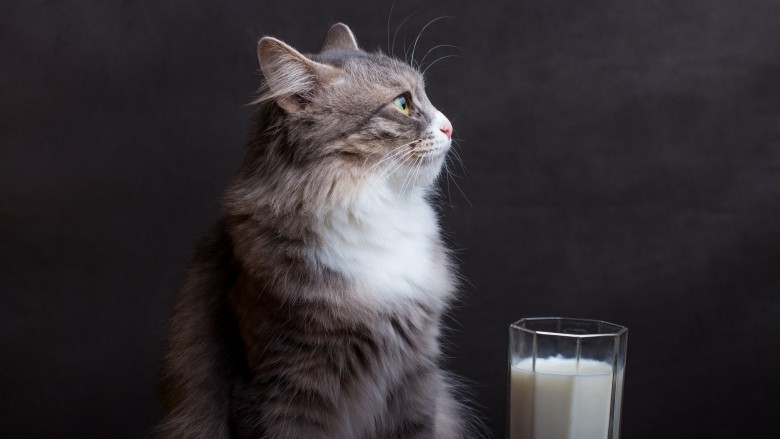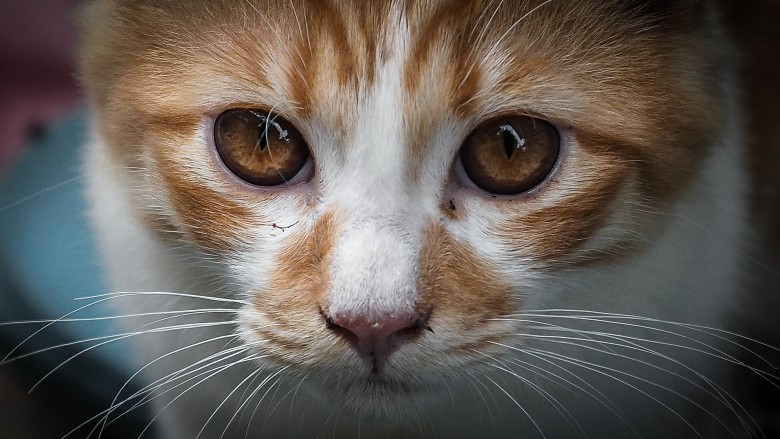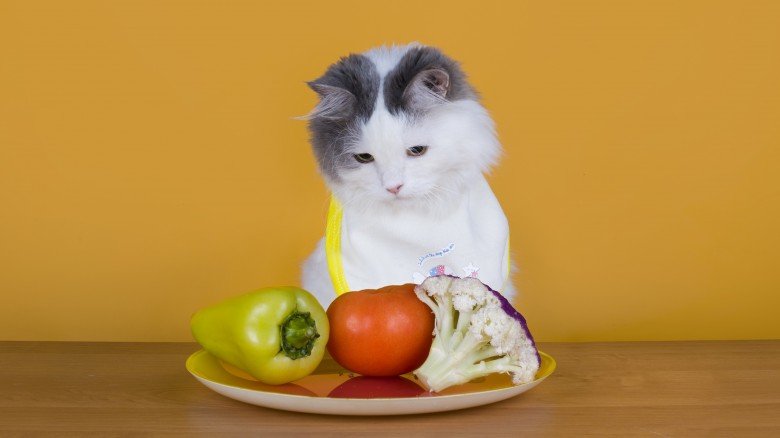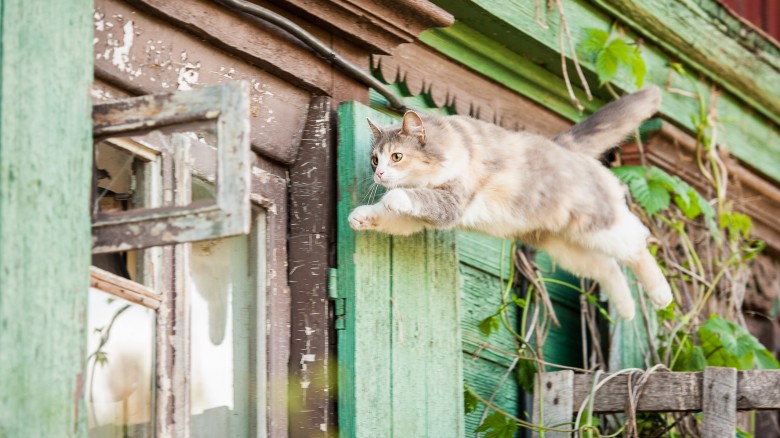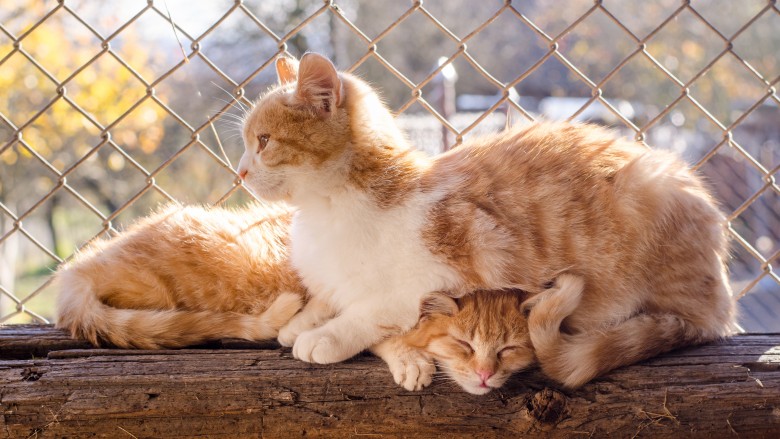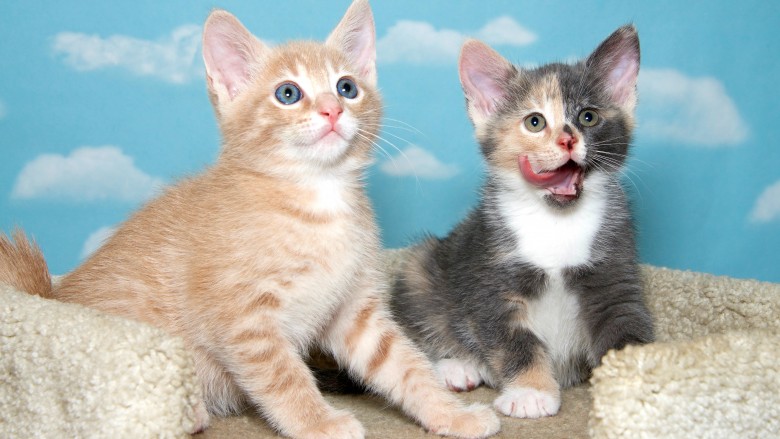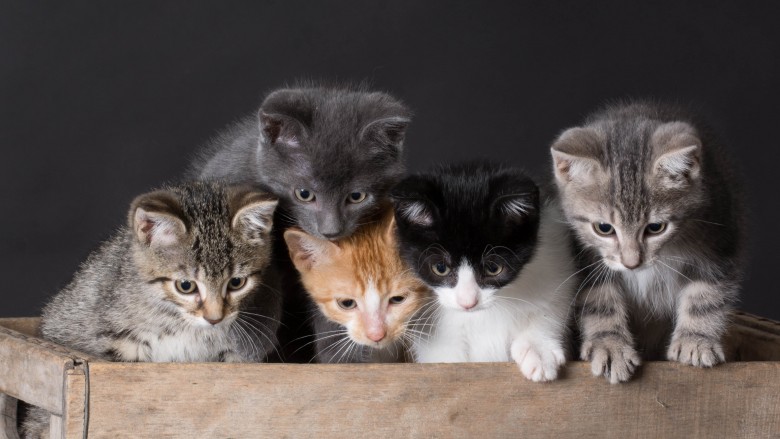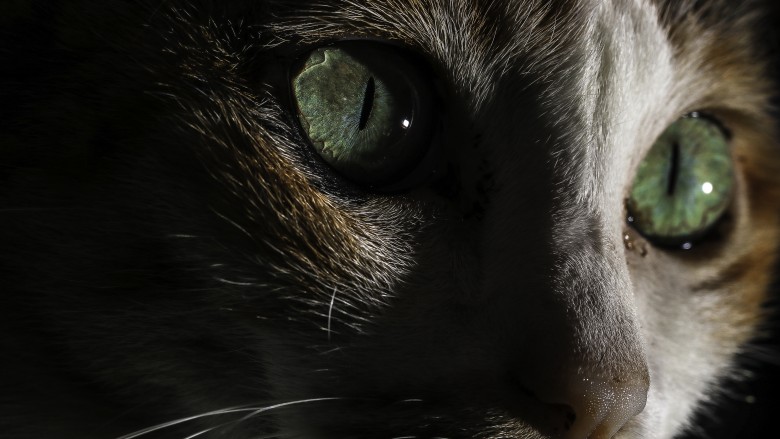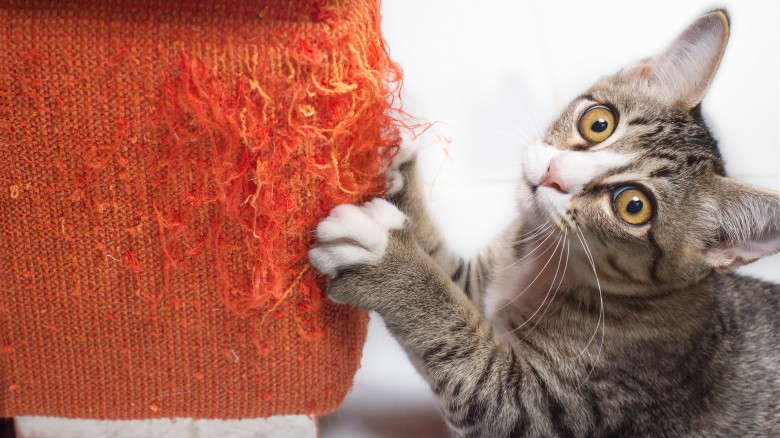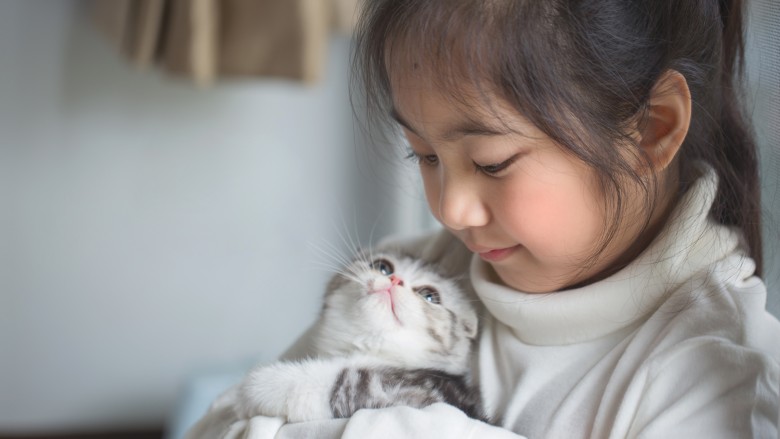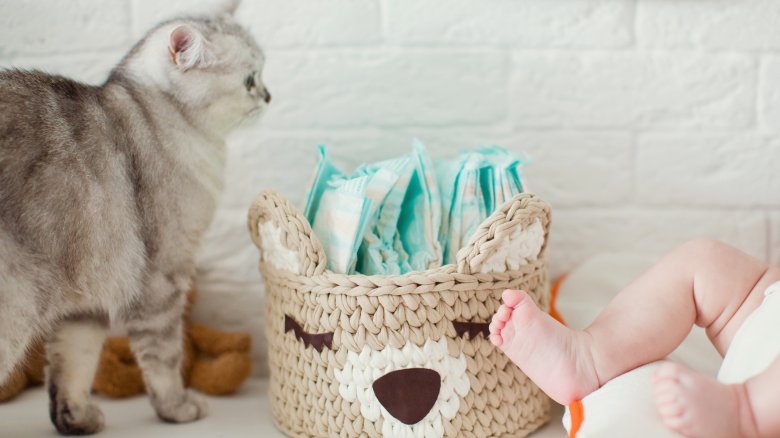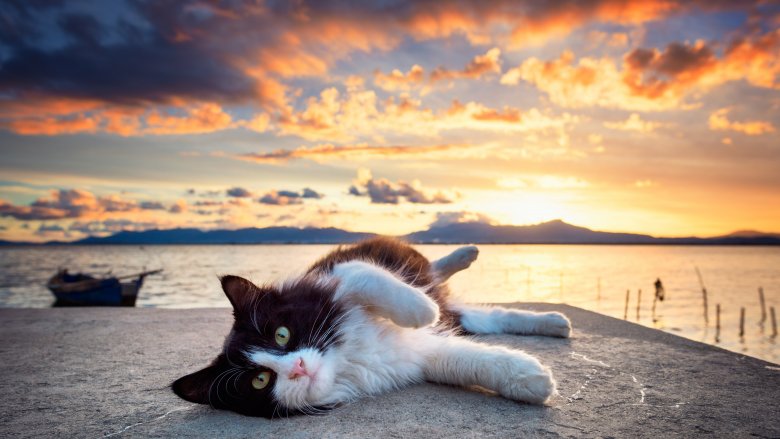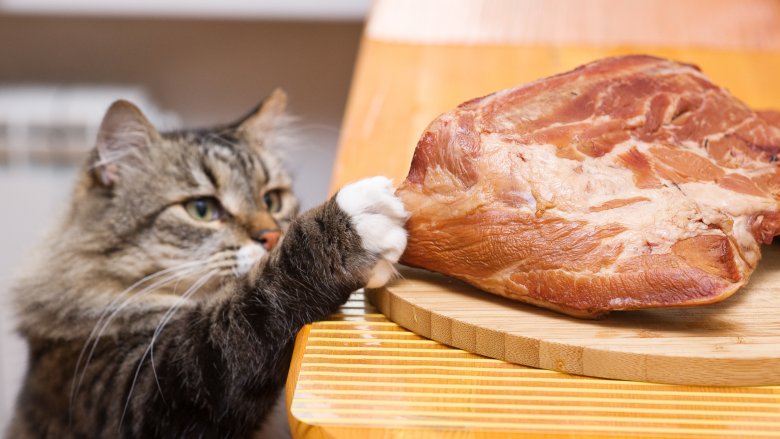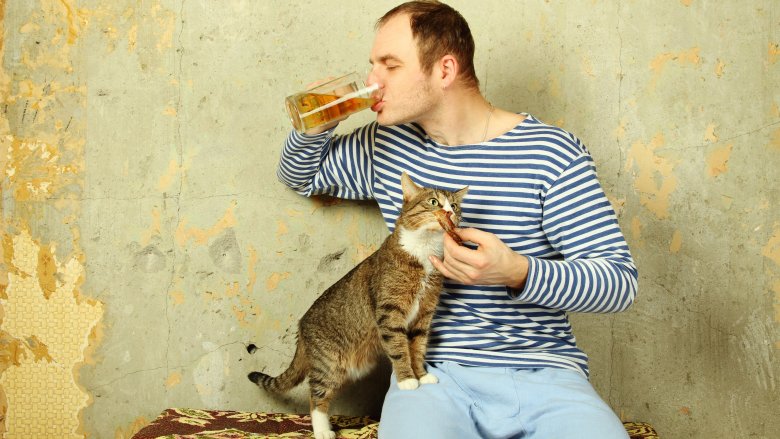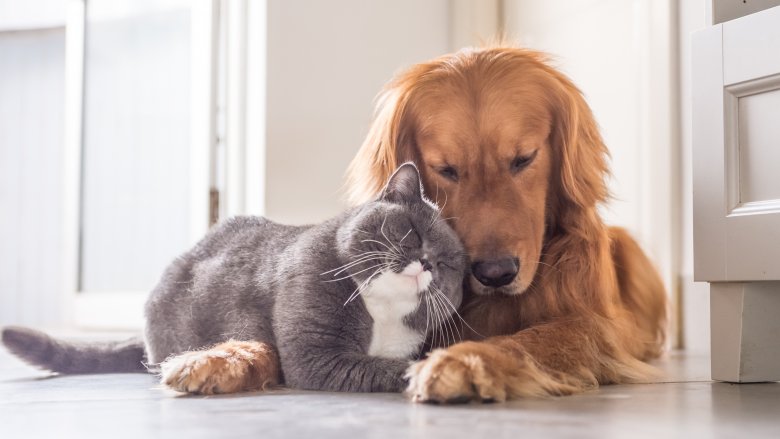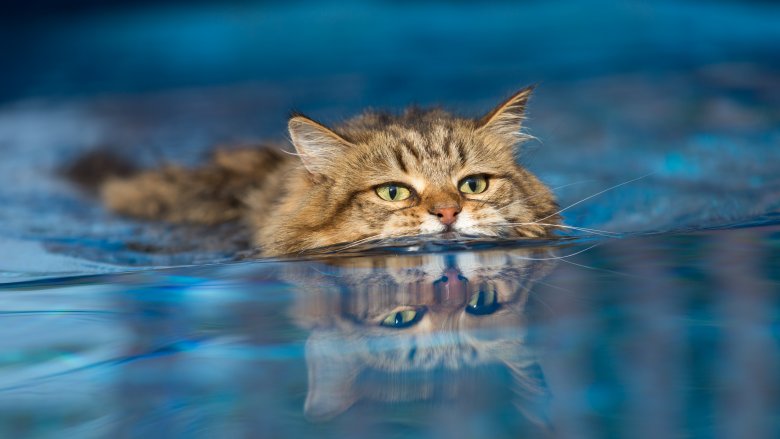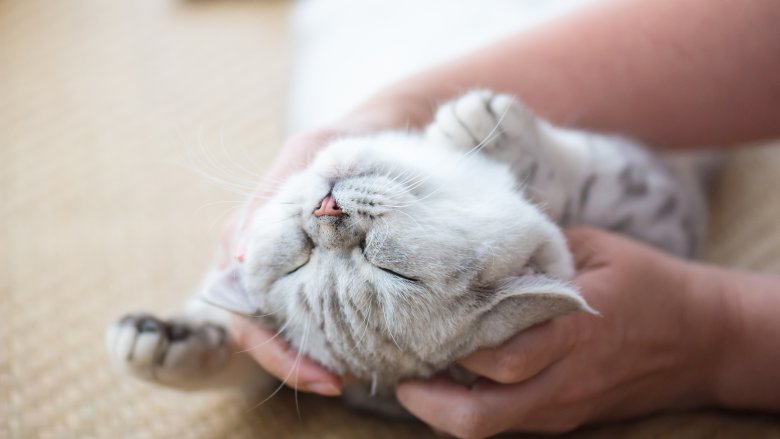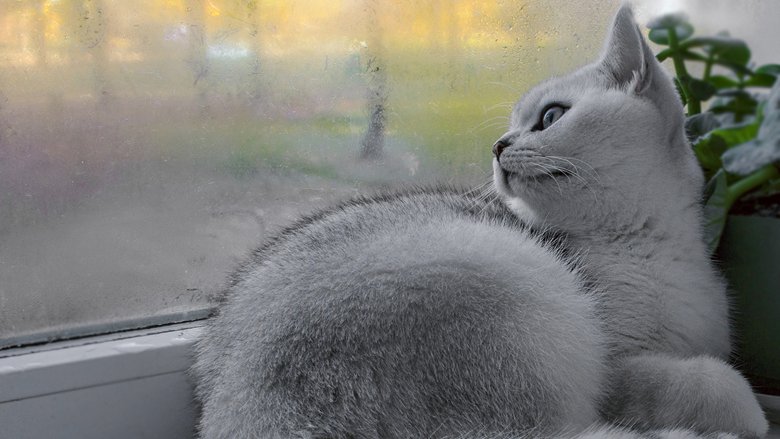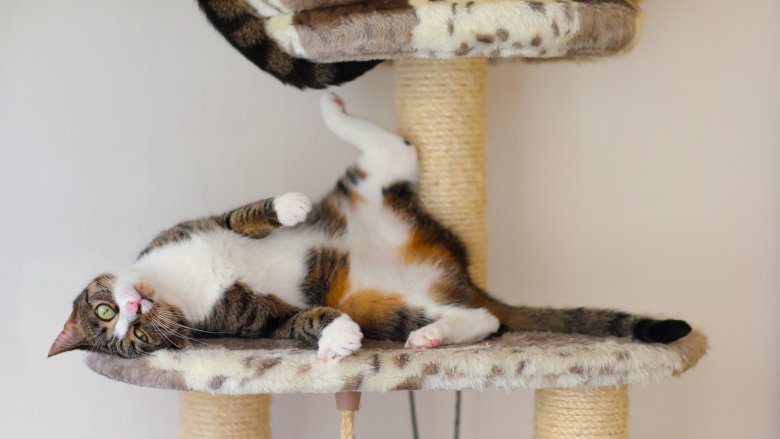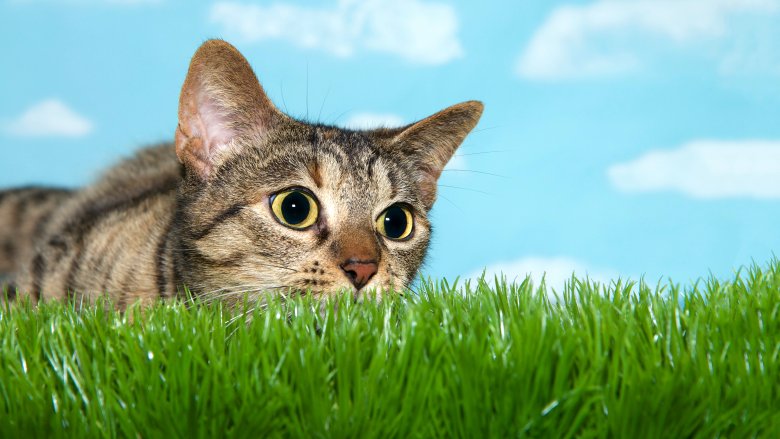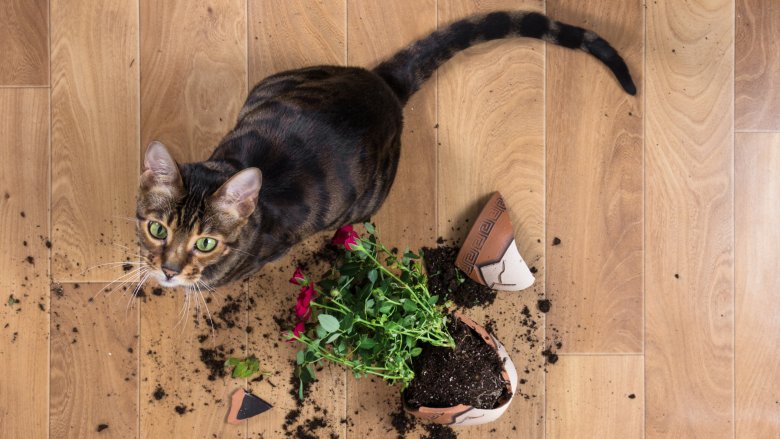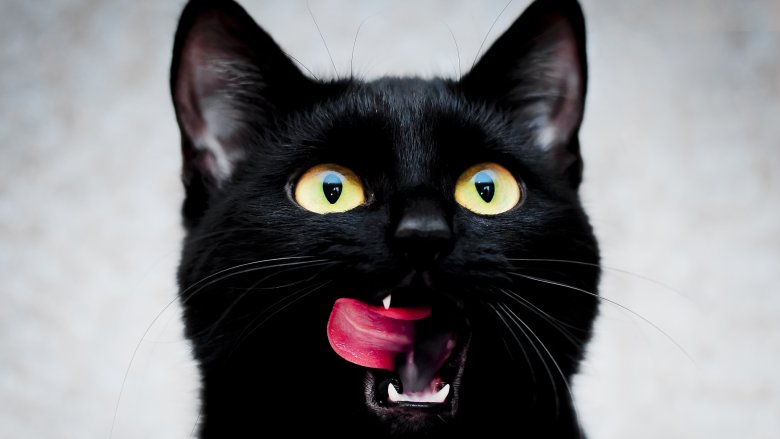Things Everyone Gets Wrong About Cats
Cats are undeniably cool. They're adorable, furry little ninjas that share our homes and have an overwhelming urge to push things off other things. We're cool with it, though, because they're so darn cute that they can get away with a lot. We opened our homes—and our hearts—to them a long time ago, but there's still a ton of misinformation floating around out there that just refuses to go away.
Myth: Cats love milk
It's in so many movies. If there's a cat, they're given a saucer of milk. That's what cats like, right?
Well, no. Cats drink milk as kittens, of course—all mammals do when young. But once they're weaned off their mother's milk, they stop producing all the enzymes they need to digest the stuff. So yes, that means that most cats are lactose intolerant, although milk and dairy in small amounts is usually all right. Regular milk's lactose collects in the cat's digestive system and leads to all sorts of stinky problems—the same problems that happen if a lactose intolerant person chugs a milkshake with their cheese-filled dinner.
There's another problem with milk, too, and that's the fat and calorie content. Give a cat a saucer of milk as big as their head, and that's like you sitting down and eating a gallon of full-fat ice cream with some extra fat for good measure. (We won't judge, we've been there.) That means not only will milk make a cat unacceptably leaky, but it'll make him fat, too. They still might like the actual taste of milk—just like you're still going to want some more of that triple-cookie-dough-chunk-fudge ice cream the next day—and that's why they make lactose-free, low-fat cat milk. We're still waiting on the ice cream version.
Myth: Their whiskers help them to balance
Firstly, what is with all the savages on the Internet asking what happens when they cut off a cat's whiskers? Just ... no. These people should not be allowed near cats.
Now, the myth. Popular belief says that whiskers are tied to a cat's sense of balance, and it makes sense that something explains their effortless ninja skills. It's not their whiskers, though, as those delicate little feelers are used for navigation and sensory perception.
That's right, they're cooler than you thought. A cat's whiskers are made of the same material that makes up other animals' horns: keratin. Where they're connected to the cat's face is a whole bunch of nerves, and they can feel the changes in the air that happen as they get closer to walls and other obstacles. If you've ever noticed the fine hairs on the top of a cat's head or on the backs of their legs (not all cats have those), those are whiskers, too, and they work the same way.
As for the rumor that the cat's whiskers are as wide as its body and lets it know if it can fit through a tight space, that much is true (as long as Puss isn't overweight). And as for cutting them off, sometimes it's necessary for the vet to do it, but you shouldn't. The loss of sensory input can make the poor cat disoriented, confused, and scared, so seriously, just don't do it.
Myth: Your cat's fine with being vegetarian
So you're a vegetarian. Congratulations! But before you put your cat on a strict vegetarian diet because you enjoy forcing your lifestyle choices on others, know that your cat is not at all fine with the idea.
A handful of nutrients that cats need to survive, like taurine and arachidonic acid, come from meat. They also need a heck of a lot of protein, more than most other animals do. They can't easily get all that from a plant-based diet, and deficiencies mean they're going to suffer from skin problems, hearing loss, and even heart and liver problems. There's also the problem of vegetarian diets being high in carbohydrates, and cats can't process that. Sure, a handful of professionals will swear a vegetarian diet is fine, but considering they're largely manufacturers of vegetarian cat food, you can guess exactly where their interests lie.
Some vegetarian diets have artificial versions of all the meat proteins cats need, and that all sounds great ... until you keep reading and find out that cats can't process artificial ingredients as efficiently as they process natural ones. That's going to mean a weakened heart and shortened lifespan, and if you're so worried about the ethics of meat consumption, what about the ethics of putting your cat through that? Research has also found that cats forced onto a vegetarian diet at home will simply head out into the great outdoors and start picking off the local wildlife to supplement the crap diet you're giving them, because they will have none of your fascist ways.
Myth: Stray cats are the same as feral cats
Stray and feral cats are often lumped into the same category: nuisances that live outside and knock over your garbage cans. But they're completely different, and here's why.
Feral cats were born and raised on the wrong side of the tracks. They've never had a good relationship with humans, they're usually scared of them, and they're definitely not going to accept your invitation to come inside and sit on your nice warm lap. They're not socialized, and they've had the kind of life that means they never will be socialized.
Stray cats, on the other hand, are pet cats that the world's been incredibly unfair to. They know people, and they know people can be kind, and they've probably been socialized at some point—and they can be again. They might be standoffish and scared, but you can earn their trust and make them lap cats again. Stray cats can turn into feral cats if they're on their own long enough, and the perfect example of a stray cat is a house pet who was kicked out and left. Both groups have gotten the short end of the stick, but stray cats can forgive. Feral cats will tell you where you can go.
Myth: Cats always land on their feet
They might land on their feet most of the time, but not always. They can do it because they have the ability to twist their spines in a way that would kill a human, so when they jump, their sense of balance aligns the front half, while the twisty spine snaps into action and reflexively aligns the back half for a safe—and impressive—landing.
Even though it's a reflex, it still takes time. If a cat falls from a low height, they commonly won't have time to flip completely, and they'll land on their side. And even if they do land on their feet, they don't always come out of the incident unscathed. If they're falling from too high and their legs can't absorb the impact, it can result in all sorts of horrible things like broken bones, internal trauma, and even brain damage. It's more common than you think, too, so common there's a name for it: high-rise syndrome. Remember that old saying about curiosity? That's true, and the ASPCA—and common sense—says that you really need to make sure your cat's safe, because not even ninjas are perfect.
Myth: Cats are solitary by nature
Dogs might be pack animals, so it's ironically cats that are usually seen as the lone wolf, staking out their own piece of territory and definitely not wanting or needing to share it with anyone—not even a human. Because who needs you, anyway? When researchers took a look at how cats interact with each other, though, they found that they are social creatures.
Cats absolutely can survive on their own, we'll say that right up front, and they almost always hunt alone. But when they do gather in groups, they form close-knit relationship that often revolve around a core group of females. Not only do feral cats gather in colonies, but they share responsibilities, team up in raising and even nursing each others' kittens, and they even have besties. Cats in feral colonies usually pair off and hang out together, spend a huge amount of time grooming each other and greeting each other with nose boops. It's thought that all that grooming isn't just about getting clean, either, but that it's a way to mingle everyone's scents into a colony odor that identifies each individual as a part of the group, kind of like sorority girls sharing clothes.
Myth: Calicos are always female, orange tabbies are always male
Always is a dangerous thing to say, unless you're talking about something like whether or not beer should be cold, or whiskey should be served on the rocks. (Always.) When it comes to cats, things are a little less certain.
In both these cases, you could replace "always" with "most" and be completely correct. You'd be more correct when it comes to calicos, as only about 1 in every 3,000 calico cats is male. On the flip side, about 1 in 3 orange tabbies is female, so while you're more likely to find a male, statistically speaking, you could have a whole flock of female orange tabbies, if you wanted. (We do.)
It's all down to genetics. The gene that makes a cat orange is only carried on the X chromosome, and when you factor in things like recessiveness, you'll find the only way to get a calico pattern is two X chromosomes. That means male cats can only present as just orange or not orange, not a mix of colors. When male calico cats do happen, that's only because they're genetically different—an XXY set of chromosomes, rather than the usual XY. There's even a name for those genetic weirdos: Klinefelter males, after the doctor who first figured this out. On the flip side, since orange is on the X chromosome, male cats are gingers with only one copy of the gene. Female cats have to inherit two, and that's why they're not as common. Also, it has nothing to do with the condition of their souls—cats do have souls, but they have no bearing on coat color.
Myth: All blue-eyed, white cats are deaf
Another form of this myth says they're all blind, and while there is a bit of a correlation between at least deafness and white cats, it's definitely not all-or-nothing. We're not entirely sure what's going on here, but deafness seems to be linked to coat color along with eye color.
Your chances are this: white cats with eyes that aren't blue have somewhere around a 20-percent chance of being deaf, white cats with one blue eye are at about a 40-percent risk, and two blue eyes bumps that up to between 65 and 85 percent. The mechanics aren't really known, but we do know that cats with one blue eye tend to be deaf on the same side, if they do end up having hearing problems. We also know that sometimes we can't even tell if they're deaf or not, because let's face it, they're not known for coming when they're called.
Myth: Color is linked to personality traits
If you want a little love bug, get an orange cat. If you want a princess, get a tortie. And if you want someone to cast spells with, get a black cat. We might be exaggerating on the last one, but it's a common belief that certain colors are associated with certain personality traits.
Researchers at UC Berkeley took a look at the myth and found absolutely no evidence to back up the theories. What they did find, though, was the belief is so firmly entrenched in the collective consciousness that light-colored cats are considered friendlier, so they get adopted more often. Cats are picked on appearance rather than personality, and since the belief usually doesn't prove true, they're often returned. So remember: don't be a cat racist.
Myth: Cats are colorblind, but can see in the dark
Cats aren't completely colorblind, but they are almost red-green colorblind ... sort of. Cats' eyes are tuned to pick up blue-violet colors as well as greenish-yellow colors, so they see the world similarly to a person who's red-green colorblind, but they pick up a bit more of the green. Cones are the eye structures responsible for color vision, and while we have more than a cat does, we also have fewer rods. That brings us to the second part of the myth.
The number of rods in a cat's eye means they process information faster than ours do, which is why they can pick up the flutter of a mouse's tail in the grass, for example. The rod cells responsible for their crazy refresh rate also help them see in the dark (and gives them an extra 20 degrees or so of peripheral vision, compared to us), but they still can't see in complete darkness. Cats need a bit of light to be able to see, but in low light and twilight conditions, they're miles ahead of humans. This is a bit of knowledge they'd like us not to forget.
Myth: Declawing is a quick fix for behavioral problems
People think declawing is painless, sort of like getting your nails cut permanently. Not quite. Declawing removes part of the cat's paws, and the human equivalent of the same procedure would be cutting off each and every one of your fingers at the first joint. Doesn't sound so harmless now, does it?
A whole bunch of medical problems are associated with declawing, like permanent nerve damage and bone spurs that make it painful for the cat to even walk. There's plenty of short-term horribleness, too, like bleeding paws and a high rate of infection. Open wounds on your feet when you're trying to use the litter box isn't something we'd wish on anyone.
That brings us to the behavioral part of the myth. People who think it's a good idea to get a cat declawed often say they do it to put an end to things like scratching the furniture or scratching humans, and while they might not be scratching, they still have teeth, and are you going to pull those out?
The moral of the story is: don't declaw, at all. It even rhymes, almost.
Myth: Cats are standoffish and aloof
People study cat behavior for a living, and yes, they work at real universities. They've found cats are every bit as affectionate and loving as dogs—they just don't express it the same way.
Researchers point to a few key findings when it comes to cat affection. Purring has traditionally been interpreted as happiness, but it's more akin to something like, "Please don't stop petting me, I rather like it." When they rub against you, it's literally the cat equivalent of giving you a big hug, and how adorable is that? There's also the slow blink, which means they're totally comfortable with you being around, and they can't fake it, either—it's an involuntary response to lowered stress hormones. They also found out that every cat and owner has their own super-secret language, which was discovered during a study that found an owner could tell exactly what a cat was saying when they were played a variety of meows ... but only if it was their cat.
So, there you have it—not only are cats affectionate, but they like you so much they develop a secret language just to talk to you. If that's not love, we don't know what is.
Myth: Cats are a danger to a newborn baby
It's impossible to tell how many cats are shuffled off to shelters because their human family is expecting, but whatever the number, it's too high. It's a complete myth that housecats routinely kill babies, either by smothering them or — because some people still believe this — stealing their breath. They have more important cat things to do anyway, like sitting in boxes.
Hard evidence this ever happened is completely lacking. A LiveScience investigation found only one death-by-cat instance ever. It happened in Plymouth in 1791, and the coroner ruled the 18-month-old child died because the cat stole its breath. Don't forget, that's only about 100 years after the Salem witch trials, and we all know the rumors about witches and cats. Cats were often blamed for misfortunes that couldn't be explained any other way, and word-of-mouth condemned the cat to a second-class family member.
According to the ASPCA, there are a few precautions expectant parents should take, but seriously, everything will be fine. Keep things like the litter box away from baby's exploring hands, teach the cat that areas like the crib are off-limits, and ... that's pretty much it. Don't try to be a good human parent by being a crappy cat parent.
Myth: Cats are nocturnal
Anyone who shares their home with a cat knows the annoyance of being woken up by nighttime sounds of shenanigans, high jinks, rascality, or a bit of monkey business going on somewhere in the house. It might even happen so often you'd think your cat is nocturnal.
Cats are actually crepuscular, which means they're most likely to be up to their antics and capers in the hours around dusk and dawn. According to the Abrams Royal Animal Clinic, this weird schedule happens naturally because a cat's normal prey is most active during these times. Makes sense, right?
The idea that cats are nocturnal is tied into another myth, too. Since they can't see in complete darkness, they tend to just sleep those hours away. You can help adjust your cat's schedule by not getting out of bed when she clearly wants you to join in with her zoomies and establishing a routine where she's not fed or rewarded for being a pest. Just remember she can't help it, it's her nature. You're the one sleeping during playtime.
Myth: Cats sleep so much because they're lazy
If you've ever left for work in the morning and have come home to find your cat in the exact same spot, you'd probably see that as proof cats are lazy. They're not.
Cat sleep patterns are more complicated than you think, and while it's true they appear to be sleeping for as much as 16 hours a day, Cat Behavior Associates say they usually aren't really sleeping. Most of a cat's snooze time is spent in a sort of doze, where all his senses are still alert and listening for prey, predators, or the crinkle-crinkle of the treat bag. Pay close attention and you'll notice his eyes are almost open and his ears are moving. He's not exactly on high alert, but sort of a DEFCON 4 with an option to go straight to DEFCON 1 if something interesting happens nearby.
According to VetStreet, there's a biological reason little Mittens needs so much downtime: diet. Cats are meat-eaters, and long periods of rest or near-rest help their digestive systems handle all that protein. Cut Mittens some slack; he's just working smarter, not harder.
Myth: Cats are happy to be waited on, hand and paw
The idea that dogs have masters and cats have servants is pretty old, but it's completely possible cats only have their holier-than-thou reputation because we've put them on a pedestal. Just look at what a feral or stray cat has to go through to get a meal. It's a lot of hunting, pouncing, or foraging, the complete opposite of Princess-Pants and the food dish she always demands be filled. Sure, she's used to unlimited food, but researchers from the University of California at Berkeley (via LiveScience) have found that's not always best for her. It might not even be what she wants.
Researchers took dozens of cats and gave them food puzzles instead of a food bowl. The results were pretty impressive. When the boredom of a free handout was taken away, overweight cats lost pounds, food-obnoxious cats got less mouthy, and other behavioral problems disappeared. Food puzzles can be as simple as serving wet food in the cups of an egg carton instead of a dish, and it turns out many cats not only work for their food, but do it willingly. Plus, it's great entertainment for us, too.
Myth: Cats think food is more important than people
If you've come home to an empty food dish and a yowling cat, you know you're only good for one thing — using those opposable thumbs to open the cat food. But a study from Oregon State University (via Science Direct) tried to find out what cats prefer. They took two groups of cats — pet cats and cats from shelters — and presented them with options of either food, socializing with a human, or playing with a toy. By the end of the tests, they found the majority of cats would opt for attention from the human even over some tasty, tasty wet food.
Toys and scent stimuli didn't even stand a chance, and while there were differences between individual cats, there wasn't a statistical difference between the pet cats and the shelter cats. Even though the adorable little test subjects tended to visit all the stations, they most wanted love from a person. Consider that next time your cat gets mouthy when you come home — he may just be mad you were gone so long.
Myth: Cats are smarter (or dumber) than dogs
Talk to a cat person, and they'll insist cats are smarter. Talk to a dog person, and it's canine brilliance that'll be touted. Both are wrong, and here's why.
The first part of the answer is simply that we don't know how smart cats are because, well, they're cats. Even Adam Miklosi, one of the world's foremost experts in animal cognition, had enough with cats after a single experiment. His colleague, Christian Agrillo, laughed when Slate asked him if he'd worked with cats; it was easier to work with fish, he said. It isn't because cats are being stubborn, though; it's because cats are programmed differently. They described dogs as being tuned to a single frequency or channel all the time, while cats are channel surfers. Not smarter, not dumber, just different in a way we don't understand yet.
Researchers from Kyoto University took some major steps in deciphering cat thought in 2017 (via the BBC). When they tested cats, dogs, and their capacity for memory, they found both animals performed equally well. They could form and recall memories, associate those memories with a real-world context, and create mental impressions of things like human facial expressions, emotions, and gestures. They seem to be about equal there, and that suggests there's a heck of a lot going on in Fluffernutter's head ... as well as Pupper's.
Myth: Cats naturally hate water
Yep, let's debunk one of the most fundamental "truths" that keeps the world spinning on its axis. Not all cats are naturally averse to water. Animal Planet suggests cats in the wild adjust their views on water depending on their environment. There are predators in the water near leopards and lions, so most avoid it. On the other hand, Asian fishing cats spend so much time splashing and paddling that they have partially webbed paws.
Now, our furry indoor friends. Some cats, like the Turkish Van, the Maine Coon, and the Bengal all tend to have a fascination with water bordering on the obsessive, and many aren't opposed to taking a swim. As for other cats, it's harder to say. Some cats are perfectly happy to splash around in puddles or water bowls, and VetStreet suggests part of a cat's aversion to water is simply because they've had negative experiences with it. Kittens that are open to exploring the bathtub but fall in unexpectedly don't want to repeat that terrifying ordeal, so they stay away. Getting soaked in a thunderstorm isn't pleasant, either. Add in the fact that most cat owners don't bother bathing their cats — they do just fine themselves — and you have a cat that avoids water. Just turn on your bathroom sink to a slow drip, close the drain, and see what Kitty thinks of a safe, comfortable experience with water.
Myth: A purring cat is a happy cat
Researchers have been trying to unlock the secrets of cat communication for a long time, but not surprisingly, cats don't like to cooperate. According to the BBC, it's only fairly recently they learned where the purr originates — a neural oscillator tucked away in the depths of the cat brain. (At least, they think that's what it's for since it doesn't do anything else.)
Feline psychology researcher Marjan Debevere has spent a lot of time watching and photographing cats, and has found different cats purr differently under different circumstances. Sure, they purr when they're happy and content, but they also purr when they're alone or with other cats. Other cat psychologists suggest it's not an involuntary reaction, but a type of communication that starts when they're kittens. Purring helps them tell Mom they're hungry, and that probably has something to do with why many purr when their human parents feed them.
In fact, the "happy" purr and the "gimme food" purr are different enough that you can tell the difference if you listen closely. There are a ton of theories about the different kinds of cat purrs, including a nifty one about a purr that resonates at the same frequency bones heal. The theory is that when kitty curls up with someone who has a headache or injury and starts purring away, they might be trying to help. Awesome if true!
Myth: Keeping an indoor cat is cruel
Everyone has an opinion, and when it comes to kids and pets, everyone definitely has their opinions on how you should be raising them. Some people believe cats should be kept as their ancestors were, allowed to roam outside, kill small animals, and potentially die a horrible death. Keeping a cat indoors is cruel, they say. Well ... they're wrong.
According to feline behaviorist Jane Ehrlich, pet cats should 100 percent be kept inside. There are plenty of reasons why, and they all stem from the fact that it's safer. Indoor cats aren't at risk of being hit by a car, being snatched by a predator, getting trapped somewhere and dying there, or being exposed to something that will make them sick. They're also going to be more well-adjusted, psychologically speaking, because they're not always on edge and looking for death around every corner.
As long as indoor cats have access to toys, cat trees, places they can climb and hide, and a safe, interactive environment, they'll live not just long lives, but happy ones. And that's what everyone wants for Fluffy, right?
Myth: All cats love to get high on catnip
There's not much that's more hilarious than watching a cat who's out of her mind on the 'nip. But cats' reputation as catnip junkies isn't actually all that deserved — a large percentage of cats aren't very interested in catnip.
According to VetStreet, somewhere between 30 and 50 percent of cats have no reaction to it whatsoever — and no kittens will react to it before they reach 3 to 6 months. Love of catnip is actually inherited, as it's connected to a gene that either makes them love it or not care about it.
And not all cats have the same reaction, either. Some get the crazies and some get mellow, and it partially depends on what they like to do with catnip. If they eat it, they'll probably chill out. Sniffing it is where the crazies come from, but sometimes, cats just don't care either way ... and what's more cat-like than that?
Myth: All cats are born hunters
A 2013 study by the Smithsonian and the U.S. Fish and Wildlife Service found cats are responsible for the deaths of as many as 3.7 billion birds and 20.7 billion small, furry creatures each year. That seems to support the widespread idea cats are born hunters, that they're death on toe beans, that they're the most adorable killing machines on the planet. They're not.
BBC Earth found big and little cats are successful a relatively small percentage of the time. And CatTime says when it comes to housecats, not all were created equal. When cats were first domesticated, they were welcomed into homes because they kept vermin away from valuable food stores. But as time went on, mankind started caring for them, feeding them, and allowing them to earn their keep in other ways, like posing for Instagram. Mousing and hunting abilities have declined in domesticated cats, simply because it's not as needed any more.
Some cats — feral cats, barn cats, and those that have grown up on the wrong side of the tracks — are still decent hunters, but pet cats? Not so much. Females tend to be better than males (probably because they've always been responsible for teaching kittens to hunt), but now that we've taught many of them they don't need to hunt outside their food dish, they don't. Unless, of course, it's feet under the covers.
Myth: You can't train cats
It's an old belief that cats do their own thing, and training efforts just aren't worth it. But training is all about communicating in a way the animal understands — and National Geographic says cats can definitely be trained, mankind has just been doing them a huge disservice.
An example illustrates it best. Say Mittens keeps getting on the stove, where she shouldn't be. Several times a day, Mittens gets scolded and yelled at, but keeps getting up there. Training fail? Nope, Mittens has been trained to realize that when she gets on the stove, she gets attention. The human is the idiot in this scenario.
Mikel Delgado of the School of Veterinary Medicine at the University of California, Davis, says this is the principle for starting to train cats: "Reward what you like and ignore what you don't like." Be consistent in ignoring bad behavior, and eventually Mittens will hit what's termed an "extinction burst," or the elimination of the bad behavior. Training cats to come when they're called is actually pretty easy, too: Just condition them with the help of a bag of treats, say their name, and suddenly, they're coming when they're called. Go figure!
Myth: Cats were first domesticated in Egypt
The ancient Egyptians usually get the credit for first domesticating cats. They definitely loved them, integrating them with their gods, painting portraits of them, mummifying them, and burying them en masse with their most important people. It's a different way of showing love. But archaeological finds suggest cats were hanging out with humans long before they weaseled their way into the Egyptians' hearts.
The Egyptians' breeding of domesticated cats has been narrowed down to kicking off around 4,000 years ago (via Science Daily). But images of cats have been discovered in early Neolithic paintings, and when archaeologists in Cyprus discovered the remains of a cat buried alongside a human of apparent importance in a burial site dated to 9,500 years ago, they realized that other peoples had beat Egyptians to it by thousands of years.
It's not clear just what relationship early humans had with early cats, but researchers say the condition of the cat's skeleton seemed to indicate it was a pet and not a sacrifice. So cats have been living the best life ever for millennia, and that's pretty cool. They deserve it.
